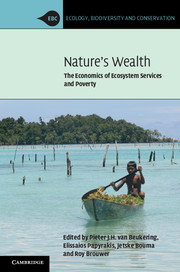Book contents
- Frontmatter
- Contents
- List of contributors
- Acknowledgements
- 1 The economics of ecosystem services and poverty
- Part I Biodiversity-related ecosystem services
- Part II Marine-related ecosystem services
- Part III Forest-related ecosystem services
- 8 Greening the charcoal chain in Tanzania
- 9 Payments for environmental services in the protected areas of the Philippines
- 10 The copper curse and forest degradation in Zambia
- 11 Institutions and forest management in the Swat region of Pakistan
- Part IV Water-related ecosystem services
- Part V Land-related ecosystem services
- Index
- References
11 - Institutions and forest management in the Swat region of Pakistan
Published online by Cambridge University Press: 05 July 2013
- Frontmatter
- Contents
- List of contributors
- Acknowledgements
- 1 The economics of ecosystem services and poverty
- Part I Biodiversity-related ecosystem services
- Part II Marine-related ecosystem services
- Part III Forest-related ecosystem services
- 8 Greening the charcoal chain in Tanzania
- 9 Payments for environmental services in the protected areas of the Philippines
- 10 The copper curse and forest degradation in Zambia
- 11 Institutions and forest management in the Swat region of Pakistan
- Part IV Water-related ecosystem services
- Part V Land-related ecosystem services
- Index
- References
Summary
Introduction
Deforestation in the north-western part of Pakistan is a long standing problem. Forest cover was 5% in 1996 compared to 20–25% in 1850 (Sungi 1996). In the district of Swat where the research was focused there is a gap (regrowth minus timbercuttings) of over 300 000 m3 for fuelwood alone (Sungi 1996). Historical accounts tell us that forests have always been an important source of income within the livelihood strategies of local populations (Barth 1985, Sultan-i-Rome 2005). Where in the past the vast expanses of forests could support these demands, high levels of population growth (doubling of the population every 15–20 years) coupled by deforestation have drastically altered the picture. Today, the local population faces ever-decreasing forest stocks with increasing threats to both the local communities (landslides, erosion) and downstream beneficiaries of the watersheds as well as increasing threats to biodiversity.
In a broader perspective, Angelsen and Wunder (2003) distinguish five dimensions in which poor people benefit from forests and forest products: the type of beneficiaries, types of forest products and services provided, the role of forest benefits within the households strategy (subsistence versus commercial use), type of natural resource management (ranging from pure natural forest extraction to (re)planted forests) and high or low return products.
- Type
- Chapter
- Information
- Nature's WealthThe Economics of Ecosystem Services and Poverty, pp. 234 - 258Publisher: Cambridge University PressPrint publication year: 2013



